|


Once upon a time, children had very few store-bought toys; they made do with sticks and stones, and they had larger families to amuse them. Today, with so many good toys available, parents have come to rely on them to entertain and teach their children. Three things are lost in this development: a certain spirit of resourcefulness that comes from needing something and having to make it, the intimate joy that comes from making something with someone else, and finally the satisfying sense of process you get when you see an idea become a real thing.
Parents do well to set aside time with their children to improvise toys from the environment around them. Sometimes this takes a special effort, for almost always there's a commercial toy that will do the job better.
You can't buy the process of making a toy, however; you can only experience it together.
Because, at this age, supertots can't make things very well by themselves or sit for very long watching you make something, the projects have to be simple. As you start them, keep in mind the goal: you want your child to acquire a taste for homemade things to counterbalance that other taste he or she is rapidly developing: the taste for buying things.
Toys from nature

|
With so many toy stores around, it's easy to overlook natural toys outside.
Pinecones
Acorns
Seeds
Nuts
Sticks
Pebbles
Logs
Leaves
Crabshells
Seashells
Feathers
Grass |
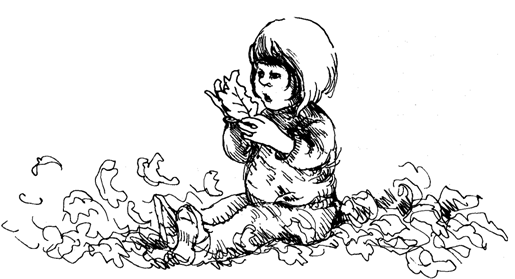 |
You and your child can collect natural toys in the woods, at the park, at the beach, and in the backyard. When you go for walks, take along a plastic container or small paper bag to hold whatever you find.
When you get home, sort out your treasures, and when you are done playing with them, store them in containers for future play. Don't let seeds and pebbles get sprinkled around the house, where they turn from treasure to trash.

Three things to do with natural toys
 |
|
Make a seashell sculpture:
You need white glue (washable), seashells, small pieces of unsplintery wood (optional), cardboard.
Pour a little glue into a small plastic saucer. Show your child how to dip the seashells and wood into the glue and stick them onto the cardboard. Your child will get glue on his or her clothes and hands. it will wash off. Extra glue dripped on the cardboard will harden and dry. |
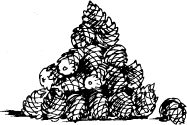 |
|
Build a pinecone pyramid:
Build it, then knock it over. (An adult or older child will be needed to get the pinecones into a pyramid of architectural perfection.) |
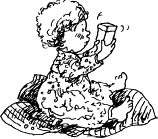 |
|
Make a rattle:
Put pebbles or seashells into an empty metal Band-Aid box with a snap-shut lid. Let your child experiment with different sounds by putting in different things to rattle around. |
More things to do with stones and nuts
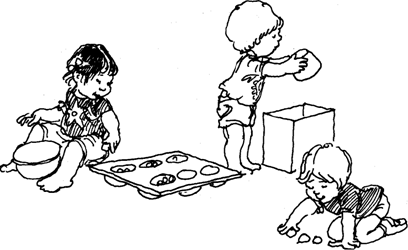
Fill up a muffin tin with pebbles.
Pour nuts into a box and take them out again.
Make a train out of stones.
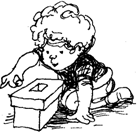
Poke stones into a small hole cut in a cardboard box.
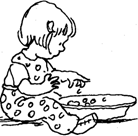
Fill a pie plate with acorns.
Mailing tube slides and rattles
Supertots love to see things go in one end of a mailing tube and come out the other end. The longer the tube, the better.
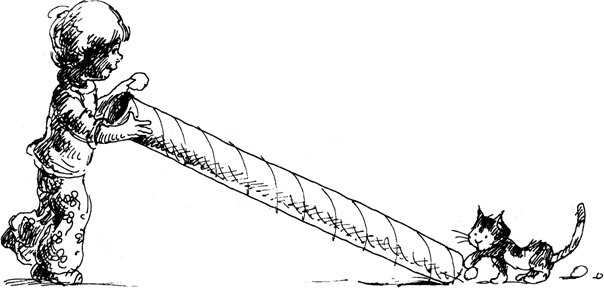
| Seal the bottom of a mailing tube with masking tape. Let your child "help." Pour in about 1/4 cup of dried lentils, rice, paper clips, or anything else you can think of that will rattle around and make noise. Seal the top. When interest in the rattle wanes, help your child take off the tape and return the contents to their original source or garbage can. Teach your child not to eat the rattle or the contents. |
|
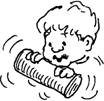 |
Nesting cans
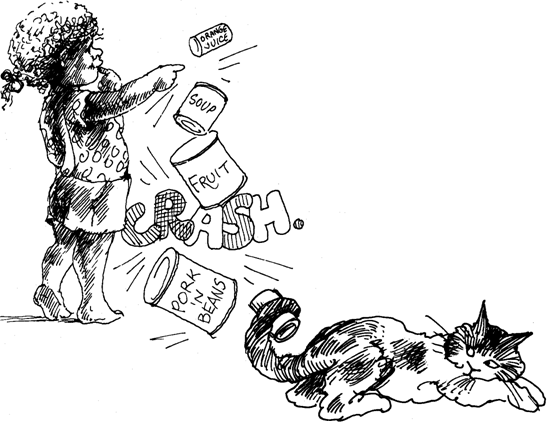
Save different-sized tin cans to make a nesting game. Cut the tops or bottoms off cleanly so there are no jagged edges, or put adhesive tape around the edges to make them smooth. Nesting cans can be stacked and knocked over with a loud, satisfying crash. Store the cans, when they're not being used, in a low kitchen cupboard accessible to your child.
What to do with boxes
 |
|
Cut a hole in a box and find toys small
enough to go inside.
Color a box. It feels different than paper.
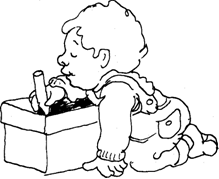
|
A big box can be a house, store, car, train, or boat.
Doll ponchos
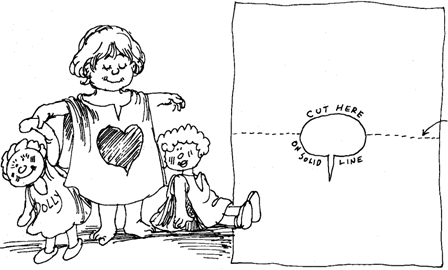
Small children who experience being dressed and undressed by big people every day love to dress and undress little dolls. The trouble is, though, that at age one and two, children don't have the manual skills to manipulate the commercial doll clothing that comes with most store-bought dolls. As a result, doll dressing becomes an activity that children can't really enjoy until they are older. You can make simple doll ponchos that your child will be able to put on his or her dolls very easily. You might also want to make a big poncho for your child.
How to make a doll poncho:
Cut a hole and slit in the center of a rectangle of fabric. No sewing is required.
Make different ponchos for different purposes:
Red: firefighter
Blue: police officer
Wool: for cold weather
Cotton: for warm weather
Long: gown
Short: shirt
Paper picture puzzles
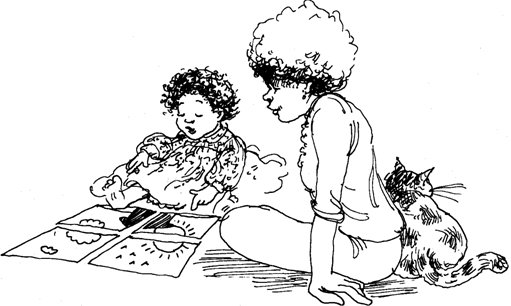
Take a fairly simple magazine or calendar picture that your child likes and cut it into four parts. Then, help your child put it back together again.
This is a quiet, intimate activity that you can do with your child during the hour before bedtime, just after his or her nap, or on a rainy day. If you cover the picture with clear contact paper before you cut it into pieces, you can save the puzzle for use at another time.
Caution: Teach your child not to use your scissors: if he or she wants to cut, provide a pair of small, blunt scissors especially made for children and sold in stores.
Inside-outside games
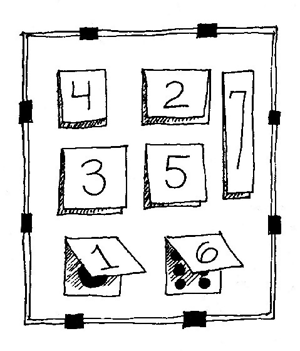
To make this, cut flaps on a large sheet of paper, as shown. Tape the paper with the flaps to another sheet of paper. Write a number on top of each flap. Lift up the flap and draw as many dots underneath as are indicated by the number on the flap.
While playing this game, don't expect too much: developmentally, your child is not yet ready to understand numbers. But he or she may be able to recognize numerals for their shape and may like to pretend to count the dots underneath. Small children today hear a lot about counting from TV and from older children; they like to pretend they know what it's about. You can pretend with them.
CLICK HERE for Chapter Five: Selecting Toys to Buy
|

